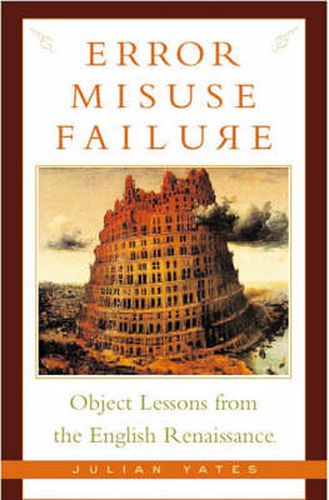Readings Newsletter
Become a Readings Member to make your shopping experience even easier.
Sign in or sign up for free!
You’re not far away from qualifying for FREE standard shipping within Australia
You’ve qualified for FREE standard shipping within Australia
The cart is loading…






If certain objects work well, no one notices them. As with black boxes,
their success may be gauged by their relative invisibility – and this was the indirect goal of the objects that Julian Yates considers here: the portrait miniature, the relic, the privy (flush toilet), the printed text, and the priest-hole (a secret hiding place for Catholic priests in Protestant England).Because each of these contrivances was prone to error, misuse, and sometimes catastrophic failure, they become in Yates’s analysis an occasion for recasting the history of the English Renaissance as object lessons – knowing from the point of view of the known. It is through such lapses – the texts and stories generated to explain away a relic that is too easily faked, a miniature that is too curiously real, the stench of a failing privy, a book that persistently sheds its pages, or the presence of so much papist trash in an ostensibly reformed England – that Yates recovers the silent work of things in cultural production.
Drawing object lessons from failing technological devices, Error, Misuse, Failure plumbs the foundations of Renaissance culture in England, recovering a curious language of mistakes, dirt, and parasitism that associates the failures of these things with the figures of Rome, Catholicism, and Sodom. Yates offers a mode of historical inquiry rooted in material culture, sensitive to the way humans induct nonhumans (animals, plants, and manufactured things) into their communities. Historically, the book offers a new set of stories about the rise of printing, the development of domestic architecture, and England’s Catholic community – stories that remind readers of the ways in whichattending to the history of nonhumans requires a radical rethinking of historical landmarks and boundaries.
$9.00 standard shipping within Australia
FREE standard shipping within Australia for orders over $100.00
Express & International shipping calculated at checkout
If certain objects work well, no one notices them. As with black boxes,
their success may be gauged by their relative invisibility – and this was the indirect goal of the objects that Julian Yates considers here: the portrait miniature, the relic, the privy (flush toilet), the printed text, and the priest-hole (a secret hiding place for Catholic priests in Protestant England).Because each of these contrivances was prone to error, misuse, and sometimes catastrophic failure, they become in Yates’s analysis an occasion for recasting the history of the English Renaissance as object lessons – knowing from the point of view of the known. It is through such lapses – the texts and stories generated to explain away a relic that is too easily faked, a miniature that is too curiously real, the stench of a failing privy, a book that persistently sheds its pages, or the presence of so much papist trash in an ostensibly reformed England – that Yates recovers the silent work of things in cultural production.
Drawing object lessons from failing technological devices, Error, Misuse, Failure plumbs the foundations of Renaissance culture in England, recovering a curious language of mistakes, dirt, and parasitism that associates the failures of these things with the figures of Rome, Catholicism, and Sodom. Yates offers a mode of historical inquiry rooted in material culture, sensitive to the way humans induct nonhumans (animals, plants, and manufactured things) into their communities. Historically, the book offers a new set of stories about the rise of printing, the development of domestic architecture, and England’s Catholic community – stories that remind readers of the ways in whichattending to the history of nonhumans requires a radical rethinking of historical landmarks and boundaries.